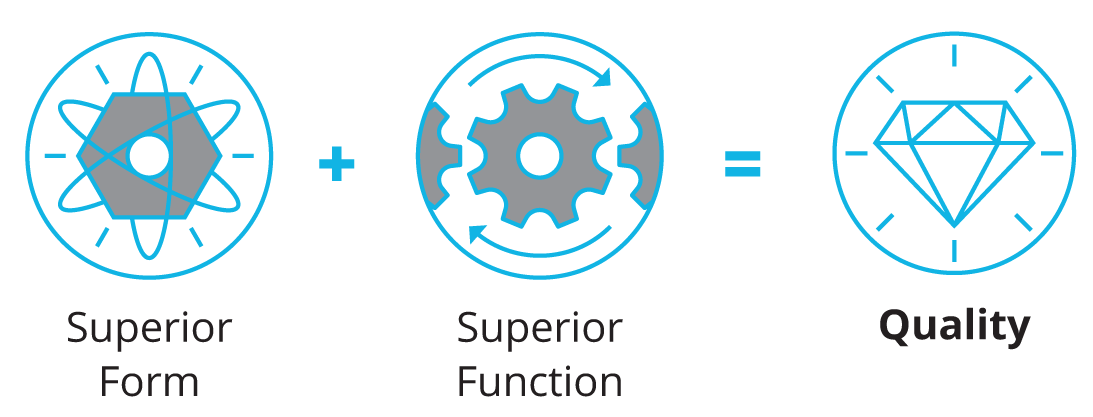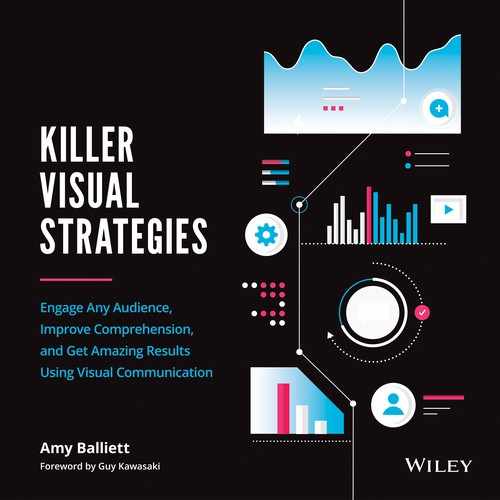CHAPTER 3
QUALITY VISUAL CONTENT REIGNS SUPREME

Figure 3.1
Source: Sillence et al., “Trust and Mistrust of Online Health Sites.”
While visual content in all its forms is king, quality visual content is the monarch that reigns supreme. Our ability to quickly process visual information ensures that we often can't stop ourselves from subconsciously judging a book by its cover. And while opinions of quality may differ from person to person, there are universal expectations that align all audiences that brands must cater to.
The concept that we are all united by a set of aesthetic expectations may be most evident in the ways in which we judge physical attraction. Everyone is unique in what appeals most to them, but audiences often find common ground and form collective opinions on whom we deem handsome or beautiful. While commonly held definitions of beauty are often social and cultural constructs rather than reflections of objective fact, they are nonetheless powerful. This widespread appeal is used by brands of all sizes to garner consumer trust, attention, and ultimately sell us their latest products or services.
We are so attracted to beauty that it can easily cloud our judgement and lead us to unfounded and often unwavering conclusions. This is called the “halo effect,” a term that was coined by the psychologist Edward Thorndike in 1920.
In 1915, Thorndike conducted a study among commanding officers in the military asking them to evaluate their subordinate soldiers across a variety of factors. They were to consider leadership, intelligence, loyalty, industry, dependability, and physical appearance as key performance indicators. For the purpose of ensuring a good sample set, all soldiers had been considered as fairly equal and consistent in their overall performance across these categories on paper. But once their physical appearance factored into the equation, the commanding officers' view of these soldiers greatly changed. A clear correlation was drawn, showing higher ratings across the board for those who were also considered to be physically appealing, while those considered less attractive earned far lower ratings across the board.
Also known as the “what is beautiful is good” principle, the halo effect suggests that people look more favorably upon those who are deemed attractive. In the same vein, more judgement is subconsciously cast upon those who are considered to be less attractive by common standards.
Decades later, studies suggested that human nature had not changed. In a 1974 study performed by psychologists David Landy and Harold Sigall, sixty male undergraduates were asked to judge an essay that they were told was written by a female college student. These undergraduates were broken into groups in which twenty were provided a photo of an ostensibly attractive author, twenty were given a photo of an unattractive author, and the other twenty were not provided a photo of the author at all. Half of the group was then given a seemingly well-written essay while the other half was given an essay in which the objective quality was considered poor.
The results of the study overwhelmingly showed that the content of the essay played less of a role in final evaluations than the writer's supposed attractiveness. In fact, students who perceived that the writer was attractive rated her more favorably than those who did not have insight into her looks. And those who viewed her as unattractive rated the work lower in perceived quality than the others, even when given the same content. This held even more true when reviewing the lower-quality essay, for which the more attractive writer received better reviews, despite the execution of the work itself. This study has been replicated throughout the years, each time leading to the same conclusions.
Brands often take advantage of the halo effect. By using celebrity endorsements and models in tandem with their products, they're subscribing to a formula that inspires seemingly instant trust and engagement among their audiences. But this effect goes beyond how we perceive people. Just as we may share common opinions on physical beauty, we often align in our impressions of design.
Perhaps one of the best ways to exemplify this lies in something as simple as website performance. Websites are a brand's most important content asset. Sites that engage viewers are often visually rich, leading with motion graphics, infographics, iconography, and more to drive users through a conversion funnel.
A study published by Swedish technology researchers Bo N. Schenkman and Fredrik U. Jönsson identified that the overall quality of a website is often judged by four key factors: beauty, use of illustrations over text, broad overview, and site structure. Of these four considerations, the perceived beauty of a website was often the best predictor of positive impressions. In other words, a poorly designed website will greatly hinder the success of the associated brand.
Quality design builds trust with a viewer, whereas something with a jumbled, rushed, or disorganized aesthetic direction often leads a viewer to question the merits of the associated brand. eBay found this to be a problem in 2010. Sellers with great ratings but poorly designed websites saw sales falter, while those that had low ratings but well-designed websites were deemed more trustworthy to purchase from. This might be why alternative auction sites online have been able to compete although eBay originally took the market by storm.
SO: BEAUTIFUL DESIGN REIGNS SUPREME?
You might be wondering why quality design is ultimately more effective than beautiful designs.
Imagine if you had the option of living in one of two houses. From a purely aesthetic perspective, both homes are extremely eye-catching. They incorporate all of the finishes you love in a house, have great curb appeal, and even have that wine cellar you've always wanted. At first glance, you would be thrilled to make your life in either of them.
But there's a reason people learn about the bones of a house prior to buying. What if one of the two houses didn't have working plumbing? What if the foundation was sinking or the walls were not insulated? Suddenly, these two homes that look the same and cost the same no longer deliver the same value for a buyer. While both catch your eye, only one can actually function in the way you need. Your perception of quality between the two homes is now quite different than it was upon first glance.
While this may be an extreme example, delivering value through your content is just as important as delivering something that's visually appealing to the viewer. Of course you can have something that looks beautiful and quickly engages your target audience simply because of the “wow” factor of the design. But to keep their attention and build long-term loyalty, your content has to deliver value beyond a pretty picture. This marriage of form (perceived beauty) and function (perceived value) combine to provide a quality end product.
The concept of balancing form and function in design is nothing new, but it is a key differentiator between simple design and true visual communication. If your sole focus is on making your visual content look good, it's unlikely that it will deliver any relevant information. While audiences may connect with and even share a beautiful image, if that design doesn't carry forward meaning, it won't inspire action. Just as a poor design will deter most audiences, delivering content that doesn't have an equal focus on function will lead to missed opportunities and minimal engagement.
According to a 2018 report from Adobe and Econsultancy, organizations that lead with a commitment to “design-driven” quality in their content are 69 percent more likely than their competitors to exceed their yearly revenue goals. By delivering content that puts an equal focus on form and function, brands have the opportunity to stand out from the crowd (Figure 3.2).

There is likely no better example of this than Netflix. What began as a mail-delivery DVD rental service evolved into the world's leading entertainment destination in under a decade. Netflix could have simply focused their efforts on delivering a great streaming experience, licensing content from production houses and making it accessible to anyone with access to the internet. But with their success, it wouldn't be long before others followed. They needed to find a solution to maintain customer loyalty, and that solution came through the prioritization of both form and function in their original content.
By moving entertainment into an online streaming platform, Netflix had millions of data points at their disposal. This data showed them which Hollywood stars were trending, what storylines mattered to different viewer demographics, which genres drove the most views, and much more. They used this data to inform the creation of bingeworthy and game-changing original content, combining production value with stories that were sure to inspire viewership.
TODAY'S AUDIENCES HAVE TWENTY-FOUR-KARAT-GOLD EXPECTATIONS
Our perceptions of quality have greatly evolved over the years, and today's media landscape has elevated our expectations beyond imagination. Streaming services such as Netflix, Hulu, and Amazon Prime have drastically altered the world of visual storytelling and entertainment through their focus on original content. Thanks to these services, we all expect blockbuster entertainment at the push of a button, and there's no going back.
By letting user preferences guide storytelling, Netflix and services like it have created a world in which quality entertainment is the daily norm, not the exception. Gone are the days when families wait for the hit Thursday-night lineup of Seinfeld, Friends, and ER. Today, we make our own lineups every night of the week, combining hit sitcoms and motion pictures of the past with a constant barrage of new releases.
Today's entertainment is star-studded, written to keep us on the edges of our seats for hours on end, and produced for 4K television sets to provide a movie-going experience in our own living rooms. Streaming content delivers twenty-four-karat-gold value to audiences around the world, and all brands must now compete to provide the same level of quality to their customers.
This shifting set of consumer expectations is leading to the death of one of the longest-standing forms of visual storytelling in modern times: television. Assurance, tax, and consulting giant PwC reports that, in 2018, Netflix surpassed consumer broadcast television as a primary source of household entertainment (Figure 3.3). This follows a multi-year trendline in which more and more viewers are moving to the platform to get their content.

Source: PwC, “A New Video World Order.”

Source: Trainer, “Netflix's Original Content Strategy Is Failing.”
But, while Netflix's strategy has disrupted the idea of “engaging” content, it has also contributed to an ever more distracted audience. The formula of delivering bingeworthy media has taught consumers to expect nothing but the best at all times, and Netflix is struggling to keep up, as evidenced by a July 2019 stock-price drop reported by David Trainer in Forbes.
As Netflix and services like it continue to throw money at the problem (Figure 3.4), brands have an opportunity to capitalize on the holes left in their audiences' viewing schedules in between seasons. Consumers continue to crave high-quality entertainment, and brands are poised to deliver. In fact, trends show that consumers are beginning to expect equally entertaining content from their favorite brands (Figure 3.5).

Source: PwC, “A New Video World Order.”
With such easy access to amazing content at our disposal, it's no wonder that 94 percent of first impressions are based entirely on design. To succeed in today's content marketplace, brands must deliver high-quality visual content at all times. If they lead with poor form and function, they risk losing brand loyalty and trust in the best-case scenario—and their entire business in the worst.
